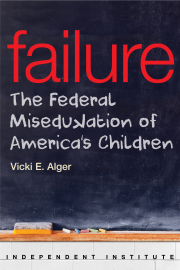There’s no such thing as a free lunch, or free college. But that didn’t stop President Obama from pushing it (again) in his final State of the Union Address, or presidential candidate Bernie Sanders in a recent interview. The biggest problem with “free college for all” is that college degrees would become as expensive and meaningless as many high school diplomas are today.
American public elementary and secondary schools spend more than $13,000 per pupil per year on average—slightly more than two-year colleges spend. That’s hardly the kind of “free” any of us can afford, even if public secondary schools were getting results—which they do, of course, but the wrong kind.
The national high school graduation rate may have reached an historic high of 82 percent, but for many students their diplomas are “tickets to nowhere that provide false assurances of academic readiness for success in college and career,” says Michael Cohen, president of Achieve. In fact, more than 50 percent of students entering community colleges today need remedial classes, and most of those students wind up dropping out.
National Assessment of Educational Progress results for 12th-grade public-school students also show that just one-quarter of students score proficient or better in math and only slightly more than one-third (36 percent) are proficient in reading.
The upshot is that American public high schools are awarding diplomas to millions of students who haven’t mastered the basics. There’s no good reason to believe that academic quality—much less college affordability—will improve by expanding the federal government’s reach into higher education or taxpayers’ wallets.
At last count our national debt was approaching $20 trillion. Mounting evidence indicates that student debt, which now exceeds $1.2 trillion, is threatening economic growth. Decades of government “financial aid” have done little to help and, according to any number of studies, have probably made matters worse, encouraging colleges and universities to increase tuition and fees. The last thing we should be doing is spending another $80 billion or more over the next decade on public two-year colleges where barely one in five students earns a degree in three years.
Better incentives, not billions more in “free” top-down government giveaways, are needed to ensure that students are prepared to earn their degrees on time without bankrupting themselves or taxpayers.
Instead of funneling hundreds of billions of taxpayer dollars annually to public institutions that let costs skyrocket with impunity, we should fund students directly through performance grants.
To qualify for these grants, students would have to demonstrate financial need and complete their chosen degree programs as stipulated. Otherwise, their grants would convert into loans that must be repaid.
With this reform, schools, two- and four-year alike, would have to compete for students and their associated grant funding, which would exert powerful pressure on schools to control costs, keep program quality high, and offer more generous institutional aid—or risk losing students to other institutions.
“Free” college—just like virtually every other “free” lunch—is a lie we’ll all wind up paying more for sooner or later. Only this time the price will come in the form of higher taxes, watered-down degrees, more government intrusion into degree choices, and a weakened economy.








